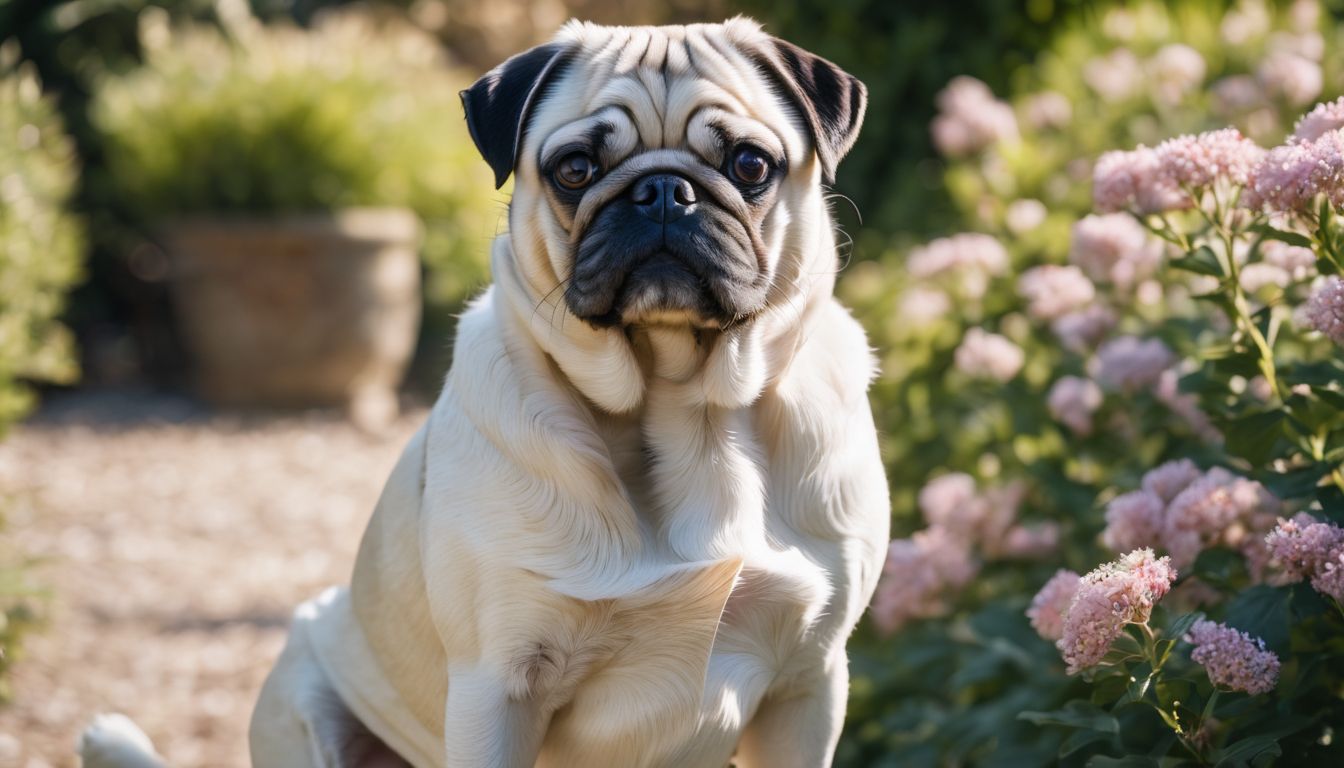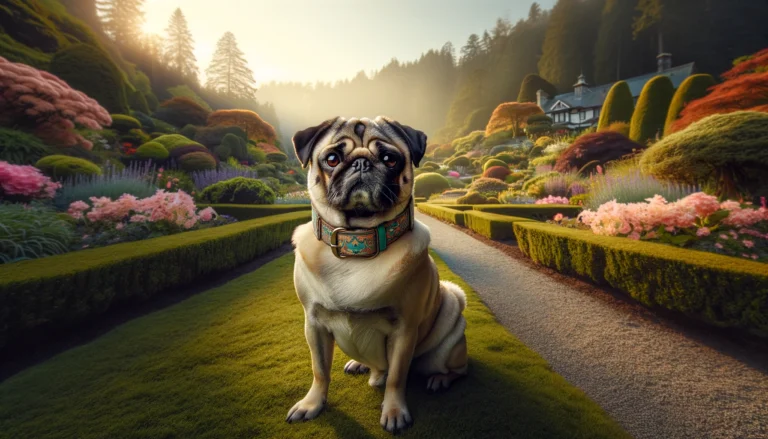Are White Pugs Rare? Unveiling The Truth Behind Their Popularity
Are White Pugs Rare?
Have you ever spotted a pug with a coat as white as snow and wondered how rare they truly are? We’ve been there too, captivated by their unique charm and digging deep to uncover the facts.
Our findings reveal that while these snowy companions are indeed a rarity, their popularity is no mystery—and we’re here to share why.
Discover the captivating world of white pugs as we explore their origins, allure, and care in our latest post!
Key Takeaways
- White pugs are not officially recognized by major kennel clubs such as the American Kennel Club, but their popularity has been soaring due to their rare and distinctive white coats.
- These dogs may carry genes for leucism or, less commonly, albinism which affects their pigmentation and can lead to specific health considerations like sensitivity to sunlight.
- Historical accounts show that white pugs have been around for centuries, often depicted with nobility and royalty, adding to their mystique and allure as pets today.
- Social media has played a significant role in elevating the status of white pugs as they become viral sensations, leading to increased demand despite potential ethical concerns in breeding practices.
- Prospective owners should be aware that white pugs require careful grooming and regular health check-ups due to common breed-related issues such as respiratory problems and susceptibilities tied to their unique coat color.
Overview of white pugs and their popularity
White pugs are a sight to behold with their snowy coats and striking features. They’ve charmed us, emerging as a beloved variation among pug enthusiasts around the world. Their rarity only heightens our fascination, as finding one feels like discovering a precious gem.
These dogs have captured hearts on social media, where viral sensations like “Marshmallow, the White Pug” showcase the unique allure of these canines.
We see white pugs often associated with luxury and exclusivity due to their uncommon appearance. Despite not being recognized by prominent breed clubs such as the American Kennel Club, they remain highly sought after.
This undeniably enhances their status within dog-loving circles and makes them subjects of countless searches for those dreaming of bringing home this rare variant of man’s best friend.
White Pug Genetics

In exploring the genetics of white pugs, we delve into a world where science meets canine curiosity. It’s here that we unravel how these unique coat colors come to life in one of our favorite dog breeds.
Understanding albinism and leucism
Albinism in pugs is a genetic condition that completely removes pigment from the fur, eyes, and skin, resulting in an all-white appearance. These albino pugs often have very light blue or pinkish eyes due to the lack of melanin.
Their unique looks can be quite striking but don’t confuse them with ordinary white pugs who simply carry a gene for white fur yet retain some pigmentation in their skin and eyes.
Leucism is different from albinism; it’s partial loss of pigment which doesn’t affect the eyes like albinism does. White pugs with leucism may have normal colored eyes and regular skin tones under their white coats.
It’s vital we understand these differences so we appreciate the special needs of these dogs and promote responsible breeding practices that prioritize health over color trends.
Difference between white pugs and albino pugs
Understanding the unique genetic makeup of our beloved pugs leads us to distinguish between white and albino individuals. While both may appear similar at first glance, key differences set them apart.
White pugs have a coat that results from a specific gene causing leucism, which reduces pigmentation uniformly across their fur. This gives them their beautiful snowy appearance while still retaining pigment in their skin and eyes.
In contrast, albino pugs lack melanin entirely due to a genetic mutation affecting all pigmentation. These dogs typically exhibit pink noses and irises because there’s no coloration anywhere on their bodies—a condition that extends beyond just the coat to include skin and eye tissues as well.
Albinos often have sensitive skin and may require extra care against sunlight due to this total absence of protective melanin.
The Earliest Records of White Pugs in History

White Pugs hold a certain mystique, having been depicted in art and literature for centuries. Unraveling their past reveals surprising connections to royalty and culture that underscore the breed’s historical significance.
Evidence of white pugs in ancient cultures
Ancient artifacts and writings reveal the presence of white pugs at the side of nobility and within royal courts. Their pristine coats were often seen as a symbol of wealth and high status, making them cherished pets among ancient rulers.
These dogs played an important role in cultural ceremonies and were sometimes regarded with mystical significance due to their striking appearance.
Carvings and scrolls dating back centuries depict these rare pugs alongside influential figures, indicating that they have been revered companions throughout history. Their unique genetic traits captured the fascination of many, solidifying their place not just in homes but also in the folklore of various civilizations.
It’s this historical allure that continues to captivate pug enthusiasts today, reminding us that our affection for these special canines is deeply rooted in our past.
Historical significance of white pugs
Tracing back through time, white pugs have always held a place of distinction in the tapestry of dog breeds. They served as cherished companions to Chinese emperors and European royalty, symbolizing wealth and refined taste.
Their historical significance is enhanced by fascinating anecdotes; for instance, legend has it that a white pug once saved Prince William the Silent by alerting him to approaching assassins.
Moreover, these delightful dogs graced the laps of notable historical figures such as Josephine Bonaparte who reputedly owned one. This connection to important personalities from history underlines not only their appeal but also their esteemed position across centuries.
White pugs continue to enchant us with their ghostly charm and remind us of their storied past, standing out among other members of this beloved breed.
How White Pugs Gained Popularity
White Pugs have experienced a surge in fame, and we’re on the trail of this trend to figure out exactly how they went from rarity to internet sensations. Their distinctive appearance has caught the eye of many, propelling them into the spotlight and cementing their status as one of today’s most sought-after pets.
Rise of social media and internet fame for white pugs
Social media has transformed white pugs into international sensations. These adorable dogs with their unique coats and striking features have amassed huge followings on platforms like Instagram and YouTube.
Celebrities often share photos of their own fluffy companions, further fueling the craze for these rare pooches. Videos featuring white pugs playfully running around or snuggling with their owners go viral, capturing hearts worldwide.
As a result, we’ve seen an uptick in the number of people searching online for white pugs for sale, eager to bring home one of these coveted lapdogs. The internet fame of “Marshmallow, the White Pug” is a testament to how much allure these animals hold in popular culture today.
Their snow-white fur brushed against vibrant backgrounds makes for perfect social media content that stands out in any feed.
Influencers and celebrities with white pugs
Famous faces and online stars love sharing their lives with white pugs, and these adorable dogs often become celebrities themselves.
Influencers’ photos and videos featuring these eye-catching pups not only highlight the unique charm of white pugs but also increase demand for them as pets.
High-profile individuals from actors to musicians can’t resist the allure of a pug’s wrinkled face and expressive eyes, especially when it comes in an uncommon white coat. As public figures post about their furry companions, they bring attention to the breed’s delightful personality regardless of color—be it fawn, black or white.
While some use their platform to advocate for responsible breeding practices given the controversy around unethical breeders exploiting the rarity of white pugs, others simply celebrate the joy that comes with owning such an endearing pet.
Formal Recognition of White Pugs
When it comes to white pugs, controversy swirls around their breeding and whether they should be officially recognized. Kennel clubs have faced heated debates over the inclusion of these eye-catching dogs in their pedigrees, highlighting the tension between breed purity and emerging variations.
Controversy surrounding white pug breeding
Breeding white pugs stirs up heated debates among dog lovers and breeders. Some see these rare, snowy-coated dogs as unique treasures, while others worry about the ethical implications.
Unscrupulous breeders may try to cash in on the rarity by producing dogs with health issues just for their color. They crossbreed or use dogs with albinism, marketing them as exotic white pugs without consideration for genetic consequences.
We find ourselves grappling with a delicate balance of admiration and concern for these little companions. As enthusiasts, we celebrate the distinct beauty of white pugs but must also advocate for responsible breeding practices.
The well-being of our furry friends should always come before aesthetics or profit. It’s crucial to educate potential owners about what lies behind that charming appearance—both its genetic background and associated care requirements—to ensure these pups live happy, healthy lives.
Official recognition by kennel clubs
Many of us cherish our pugs for their delightful personalities and unique appearance, but when it comes to white pugs, there’s a twist in their tale. These snowy companions aren’t officially recognized by major breed organizations like the American Kennel Club.
Related Article: Are Brindle Pugs Rare?
The standard colors accepted are fawn and black with variations, leaving these rare white beauties outside the show ring spotlight.
Despite this lack of formal recognition, the love and fascination for white pugs continue to grow among enthusiasts. Their rarity and distinctive look have propelled them to internet fame, although we should be wary of unethical breeding practices that might arise from their popularity.
It’s important for us as a community of pug lovers to advocate for healthy breeding while celebrating our dogs’ uniqueness in all its forms – official stamp or not.
Top 3 Unique Facts About White Pugs
While many are drawn to the charm of white pugs, there’s a trove of remarkable stories and features unique to these porcelain-coated companions that extend beyond their captivating appearance.
We’re eager to share some lesser-known facts about these dogs that will not only surprise you but also deepen your appreciation for this extraordinary version of the beloved pug breed.
Pink pigmentation in albino pugs
Albino pugs are a special sight, with their snowy coats and striking features. These rare pups often have pink pigmentation around their eyes, noses, and mouths due to the lack of melanin in their skin.
This unique trait catches the eye and warms the heart of many pug enthusiasts around the world.
Caring for an albino pug requires extra attention as their delicate skin is sensitive to sunlight. It’s essential to protect them from excessive sun exposure to prevent health problems.
Their gentle looks may be captivating, but we make sure they stay healthy and happy too!
White pugs saved William the Silent’s life
White pugs haven’t just recently captured our hearts; they’ve been making history for centuries. Imagine the year 1572, a quiet night in the Netherlands, and Prince William of Orange, also known as William the Silent.
His loyal white pug‘s sharp senses and strong bark alerted him to approaching Spanish assassins, ultimately saving his life. This act of bravery turned the little white dog into a legend among pug lovers everywhere.
Josephine Bonaparte’s pet white pug
Josephine Bonaparte, wife of the famous Napoleon, was known to adore her pet white pug. This elegant little dog wasn’t just a fashion statement; it held sentimental value and stood as a symbol of loyalty for Josephine.
Historically, pugs have been cherished companions among nobility, and Josephine’s fondness for her white pug showcases their enduring appeal throughout the ages. Her pet’s rarity only heightened its allure among those in high society.
As lovers of these charming canines ourselves, we can’t help but be fascinated by this tidbit from history that connects us to past enthusiasts. By embracing such unique pets as part of their lives, figures like Josephine Bonaparte contributed significantly to the prestige and desirability surrounding white pugs today.
The presence of this unusual-colored pooch within royal circles amplified their mystique and cemented them as beloved members across various echelons in society.
White Pug Health and Care
White Pugs can be as charming and lovable as they come, but their distinctive coat could mean unique health challenges that potential owners need to understand – for more on how to keep these pups happy and healthy, keep reading.
Potential health issues
White pugs may look different with their snowy coats, but they face health challenges like any other member of their breed. Their unique coloration doesn’t protect them from common pug issues such as respiratory problems due to their flat faces or potential joint issues as they age.
These dogs can also suffer from skin conditions given the lack of pigmentation which might expose them more to sunburns and other dermatological sensitivities.
Caring for these special pooches means being extra vigilant about their health needs. Regular vet check-ups are essential to catch any early signs of distress in areas like eye health—which is paramount considering white pugs might have lesser pigment protecting their eyes—and ear infections, which are typical in the breed due to their distinctive folded ears.
It’s crucial to monitor food intake too, since obesity can exacerbate breathing difficulties and put additional strain on already vulnerable joints.
Proper care and grooming for white pugs
Caring for white pugs demands a bit more attention due to their unique coats. Their pristine white fur can pick up dirt and stains more easily, so we need to bathe them regularly with a gentle dog shampoo that won’t irritate their skin.
Brushing your pug’s coat multiple times a week helps control shedding and keeps the fur looking shiny and clean.
It’s important to check their folds frequently as well; these areas can harbor bacteria leading to infections if not cleaned properly. Use soft, damp cloths to wipe in between the wrinkles.
Pay extra care around the eyes where discharge could accumulate, which is particularly noticeable on their white faces. Keep nails trimmed and ears clean too, as good hygiene contributes greatly to our beloved companions’ overall health.
Are White Pugs Rare Conclusion
Deciding to bring a white pug into your life is a big decision. We understand the charm and allure of their rare coloring; those pristine coats make them stand out in a crowd. But let’s not forget, that these dogs need specialized care due to potential health issues linked with their unique genetics.
You’ll want to be prepared for pink noses that can be sensitive to sunlight and possibly blue eyes needing extra attention.
Our love for these captivating companions drives us to ensure they live happy, healthy lives. If you choose a white pug, commit wholeheartedly to providing them with the best care possible.
Seek reputable breeders who prioritize the well-being of their puppies over profit, as this helps prevent supporting unethical practices. Ultimately, if your heart is set on adding a sparkling white canine friend to your family and you’re willing to meet their needs, then a white pug might just be the perfect addition for you.
Are White Pugs Rare FAQs
1. What colors do standard pugs come in?
Standard pugs typically have coats that are fawn or black, which are the most common pug colors recognized by the American Kennel Club (AKC).
2. Are white pugs considered purebred?
White pugs may not be recognized as standard purebreds by the AKC. If a pug is white, it could be due to albinism or leucistic genes, which are less common.
3. Can you find a merle colored Pug?
Merle is not a natural color for purebred Pugs; instead, merle often appears in crossbreeds like those between Pugs and other dog breeds such as Chihuahuas or French Bulldogs.
4. Why might some people think there are white Pugs?
People might mistake lightly colored fawn Pugs for being white, or they may see designer dogs that are crossbred with other small breeds like Maltese or Shih Tzus showing lighter coat colors.
5. Do designer dogs have different coat types from standard Pugs?
Yes, designer dogs that mix breeds can inherit various coat attributes like double coats from one breed and different markings such as brindles from another—these features vary widely among mixed-breeds.
6. Can breeding affect a dog’s eye color?
Crossbreeding sometimes results in unexpected traits such as blue eyes—a feature not typical of the dark brown-eyed standard Frenchie—and may also introduce unique characteristics like the silver-gray hue found in Weimaraners.







